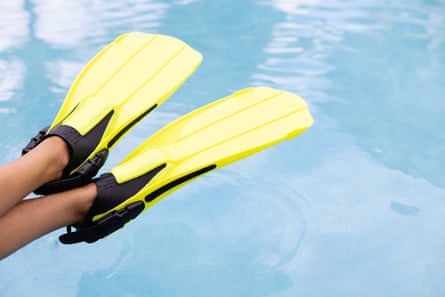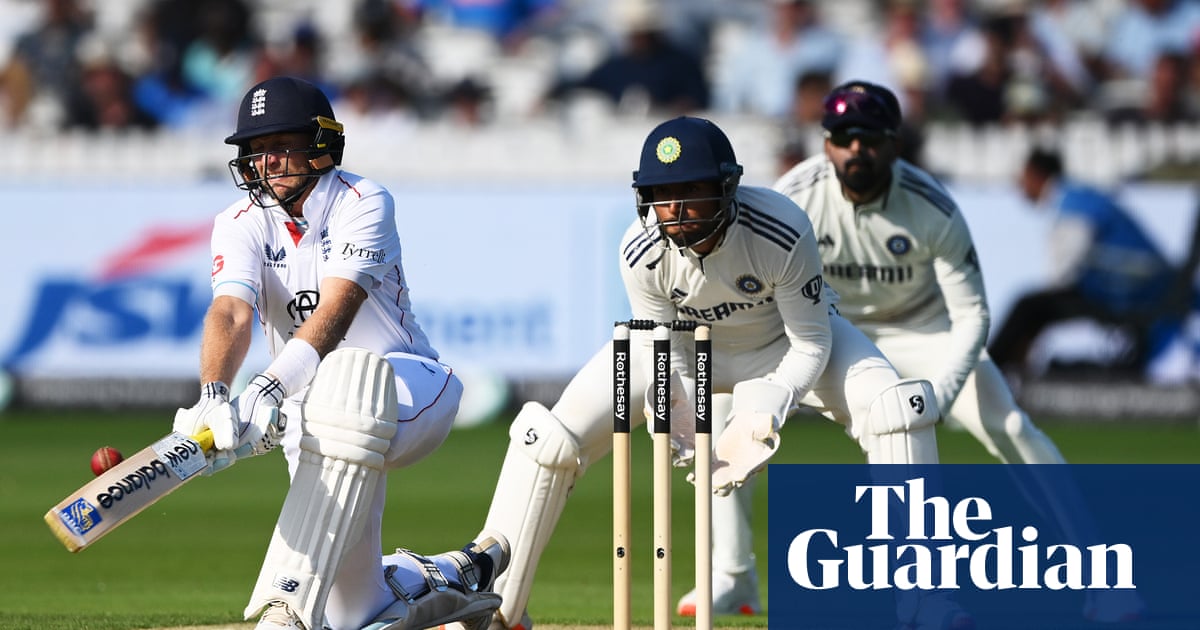Mine is a familiar story: I used to hate even the idea of running. But, in 2020, when gyms closed their doors, I downloaded the Couch to 5k app, and ran approximately three times a week for the next four years, culminating in a half marathon in 2024 – and, predictably, an injury.
Physios treating my persistent hip pain didn’t tell me to stop running – but they did suggest I might want to explore other, lower impact options, such as swimming. But where to start? What’s the aquatic version of Couch to 5k or parkrun?
To be clear, I know how to swim. I swam frequently and enthusiastically as a child, but it’s been a while since I did anything but pootle about in the pool at a spa, or tread water in the sea on holiday. Regular swimming – swimming for fitness – has always felt like a faff: I can’t do it from my doorstep, I have to take stuff with me, change twice and rinse out the chlorine before I can leave. But, armed with a reason to give it a good go, I invest in a pair of goggles, a swimming cap and (ambitiously) a pair of waterproof headphones, and head to my local leisure centre.
Week one
I have no idea what kind of swimming goals are realistic, but a friend tells me she swims 40 lengths in 40 minutes, and this seems as good a place to start as any. Of course, this rather depends on the length of your pool, and your ability to keep count; in my case, I suspect both may be limited. Thankfully, my Apple Watch has a never-previously-used Pool Swim function, which will keep track of my distance for me.
The headphones prove entirely incompatible with the swimming cap and, paired with Saturday morning’s shrieking children, are rendered almost useless. Back they go in the locker. This is a worry – I have always relied on podcasts to make a run feel more productive and make the time pass quickly. Without an audio distraction, or even an interesting route to enjoy, I’ve nothing to fill my head but my own thoughts. It’s like rawdogging a treadmill workout, for want of a better comparison.
What’s more, fiddling about with the cap and the goggles has cost me precious swimming time: when I eventually make it into the water, I’m down to just 30 minutes until I need to head back to the changing rooms. Still, my watch tells me I swim more than 30 lengths – hurrah! – and, honestly, I’m knackered.
Week two
I’m not quite brave enough yet to attempt the world of wild swimming – despite encouragement from its many, many, devotees – and, unless you happen to live close to a suitable body of water, I suspect it’s hard to make it part of your regular fitness routine. Instead, I decide to mix it up with a swim in one of David Lloyd’s outdoor pools. The water’s heated, but it’s still a bracing experience – I quickly forget all about the lack of headphones and fall into a rhythm. Maybe this is the right kind of pool for me?
“Water’s water at the end of the day – it doesn’t really matter where you swim,” says Raj Singh, head coach at Sandwell Aquatics Club. He does, however, advise me to go armed with a plan, and to mix up my strokes. “Warm up and cool down as you would with any other sport,” he says. “Front crawl is probably the best stroke to develop speed and aerobic capacity, but doing other strokes in the warm up/down is the best way to get a full body workout and avoid repetitive strain injuries.”
He suggests starting out with a goal of swimming 600m in half an hour. “You can break it down: 100m or 200m warm up, then eight lots of 50m. If your pace is what you want to improve, then you could measure this using the stopwatch function on your smartwatch and say: every 90 seconds, I’m going to do 50m – but trying to come in under 75 seconds, to give yourself rest time. If you find that comfortable, you can drop your target down or, depending on how much time you have, you could try and swim further – swim for 45 minutes, say.”
Singh tells me that MySwimPro is one of the most popular swimming apps, so I download the week-long free trial. At £179.99 annually – or £199.99 for additional dry-land strength and mobility workouts – the full subscription doesn’t come cheap; Strava, by comparison, has an unlimited free version, with paid subscribers getting a more extensive service for just £54.99 annually. Still, it’s choc-full of training plans and guided workouts for everyone from beginners to advanced swimmers. There are “achievements” to tick off that include 5K swims, but also Strait of Gibraltar swims (14,000m) and even the English Channel (36,200m).
I do like a challenge, but perhaps I’m not quite there yet.

Week three
Between downloading the app and purchasing a pair of goggles, the algorithm has clocked my interest in swimming and I’m suddenly bombarded with swimming ads and “swimfluencers” online. This isn’t entirely a bad thing – there’s nothing like a svelte former Olympian to motivate me back to the water – and I follow a few of those offering useful technique tips.
A friend recommends the Effortless Swimming account – and, while “effortless” feels like a stretch, it’s hard to argue with 323k followers on Instagram. Brenton Ford, founder and coach of Effortless Swimming, tells me: “Swimming your first 1km is a good target for new swimmers.
“This can take a few weeks to build up to, so allow yourself to gradually increase the distance each session and build up the stamina over time,” he says. One kilometre is almost double my previous distance goal, but I’m game.
Ford also suggests swimming with a friend or joining a swim club. “Even though you can’t talk when you’re swimming, it can be a very social activity between laps or before and after swims”. He’s not the first person to suggest group swimming – Singh mentioned it too – but I’m sceptical; I never got on with running clubs – AKA the new dating apps – and always preferred to exercise alone. But, determined to make my newfound swim habit stick, I contact Hackney Aquatics Club (HAC) which promises “an inclusive, encouraging and enjoyable” experience. They let me come along for a taster session, although they have a lengthy waiting list. Interest in swimming has increased in recent years: The 2024 State of the UK Swimming Industry found that the swim school at GLL (the UK’s largest pool provider) had 220,000 students participating each week, a 4% increase on the previous year.

HAC asks that attendees be able to swim a minimum of 2–2.5km per session – a distance I’m yet to achieve. But, given the 1.5 hour duration of our Tuesday night meet, I reason it should be possible.
But I fess up as soon as I meet Dorothy Whyte, a kind but firm coach, who swiftly ushers me towards the slowest of the lanes occupied by HAC. About 80% of their members have swum competitively at some point in their lives, she tells me – and do I have my own fins? I do not – not that I believe they would have brought me up to speed with my lane buddies, who all glide past me like nimble merpeople. Even the warm up is exhausting, and that’s before the drills – exercises that target one part of your stroke at a time. That said, everyone is very friendly: “Hang in there!” cheers one man, before tumble-turning away from me.
I give HAC an Insta-follow and conclude that I’m perhaps not quite at the swim club stage yet.
Week four
Time to attempt Ford’s other suggestion: a 1km swim. Over the past few weeks I’ve learned that, like running, some swims are just better than others: faster, or easier, or simply more enjoyable. A “good” swim is rarely predictable but there are some things that help. Clean pools with designated lane swimming have become a must. Decent hairdryers and showers you don’t have to prod every 20 seconds to turn back on are certainly preferable. And always, always, pack a banana for afterwards.
I’ve learned which centres require a padlock for their lockers, which use a magnetic wristband, and which require me to rummage around in the bottom of my bag for an ancient 20p coin. Swimming on a weekday during the day is a luxury, but it’s certainly when I would aim to go, given the choice. Not all pools allow you to take in fins, but it might be worth me investing in hand paddles if I want to build strength.
I head to Strathclyde Sport in Glasgow, a university-adjacent fitness centre with a 25m six-lane pool, plus steam room and sauna – a reward, I try to convince myself, for reaching that 1km goal. I begin plugging away, front crawling my way up and down each length, checking my watch every time I reach the shallow end. This, I think, is going to be a slog.
Then, something shifts. I remember Singh’s advice about switching up my strokes and throw in some backstroke, my childhood swimming coach’s refrain of “thumb out, little finger in” suddenly repeating in my mind. I stop thinking about time, pace, or my banana, and start counting as I move: one, two, three, breathe. Whyte had said my front crawl kicking technique was good, but I needed to keep my chin down, almost tucked under, so I practise doing this, not lifting my head quite so far out of the water when I need to take in air.
I glance down at my watch and, to my surprise, I’m at 900m – almost done! I cool down with some easy lengths, before heading to the steam room to bask in my achievement. I’m not sweaty or achy, the way I’m used to feeling after a running challenge, but I do feel refreshed, invigorated and a little bit relieved. I’m pleased to have ticked off a small but significant milestone – part of the fun of any new exercise is surely securing the high of a personal best. Right, I think, as I wash the chlorine out my hair: what next?

 1 month ago
36
1 month ago
36

















































